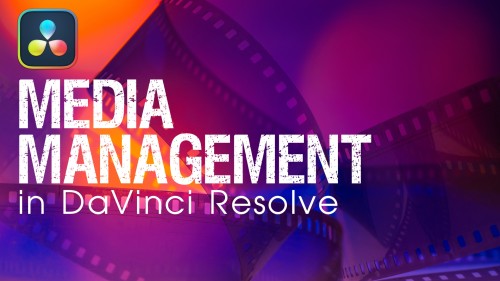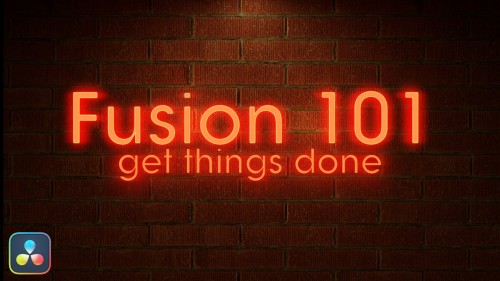- Use Color, Log and HDR Wheels
- Grade subjects with Magic Mask 2
- Isolate & grade skin tones
- Understand color management
- Grade clips in groups
- Grade HDR Projects
Color Grading in DaVinci Resolve 20
$199.00
Color Grade with Confidence
Using our provided project, you’ll jump right in and begin color grading a wide variety of footage. You’ll learn the best approaches for setting the tonal range and contrast for each shot using color wheels and curves. You’ll also learn how to create a shot matching strategy that will make your grading sessions more disciplined and ultimately more productive.
Make Precise Color Adjustments
Color grading often requires isolating objects in the image so they can be adjusted without affecting other parts of the image. One of the best tools for this purpose is the improved Color Warper. Mark will show you why this tool is often a better choice than an HSL qualifier because it’s more precise, allowing you to get cleaner selections with less banding and other artifacts.
Leverage AI to Grade
With Magic Mask 2 (Studio version only), elements such as faces, clothing, human bodies, and even objects can be isolated using Resolve’s Neural Engine. You’ll learn how to combine Magic Mask 2 with qualifiers for making selections that would otherwise be impossible to achieve in other grading applications.
Optimize Your Grading Workflow
Helping you work more efficiently in Resolve is a big focus of this tutorial. In this example, Mark shows you how to use Shared Nodes for linking your grades to other clips so that when you make changes to one, all other clips that share that node receive your changes.
Color Grading in DaVinci Resolve 20
1. Getting Started
- Tutorial Goals
- Tutorial Organization
- Importing the Project File
- Checking and Relinking Media
- Refreshing Timeline Thumbnails
- Starting and Completed Timelines
- Checking Project Settings
- Setting the Render Cache
- A Note on Monitoring
- A Note on Control Surfaces
- 3-Button Mouse
- Resolve Studio Color Page Features
- The Art and Science of Color Grading
2. A Grading Framework
3. Color Theory Concepts
- The Additive RGB Color Model
- RGB vs. HSB Color Models
- Color Temperature
- What is a Color Space?
- Capture Color Spaces
- Delivery Color Spaces
- Working Color Spaces
4. Setting Up for Normalization
- Setting up the Resolve UI
- Breaking Down Normalization
- Evaluating a Gradient
5. Grading Dynamic Range on Rec 709
- Evaluating Dynamic Ranges
- Using the Primaries – Color Wheels
6. Grading Color Balance on Rec 709
- Showing RGB Picker Values
- Color Balance in the Waveform
- Auto White Balance
- Adjusting Lift by Channel
7. Normalizing Exposure
- Normalizing an Underexposed Clip
- Normalizing an Overexposed Clip
- Normalizing with White and Grey Cards
8. Correcting Color Temperature
- Good Color Temperature
- Temperature Too Low
- Color Before Dynamic Range
- Wiping a Timeline Clip
- Understanding Luma Mix
- Temperature Too High
9. Normalizing LOG
- Why Not Grade a Log Clip Manually?
- Normalizing Dynamic Range with LGG
- Manually Color Balancing a Log Clip
- Auto-balancing a Log Clip
- Comparing with a Still
- Manually Adding Saturation
- Working with Contrast
10. Normalizing with Log Wheels
- Color and Log Wheels on a Gradient
- Adjust Targeted Tonal Ranges with Log Wheels
- Grading a Log Clip with a LUT Applied
- Color Wheels vs Log Wheels
- HDR Wheels vs Log Wheels
11. Normalizing with Color Match
- Adjusting Color Match
- Copying Color Match
12. Adjustment Bar Controls
- Shadows vs. Lift
- Highlights vs. Gain
- Color Controls
- Mid-tone Detail
- Color Boost
- Hue
13. Step 1 Review
14. Normalizing with Custom Curves
- Resetting Grades on Multiple Clips
- How Custom Curves Relate to Color Wheels
- Adjusting Dynamic Range with Custom Curves
- Adjusting Color Balance with Custom Curves
- The Effect of Adjusting Unganged Luminance on Saturation
- Custom Curves and Increasing Saturation
- Adjusting Color Balance before Dynamic Range with Curves
- Custom Curves and Luma Mix
15. Using Custom Curves on LOG Clips
- Using Custom Curves on a LUT-corrected Clip
- Limiting Luma Adjustment Ranges on Custom Curves
- Intensity Adjustments
- Using Soft Clip
- The YSFX Slider
16. Shot Matching
- Shot Matching Example 1
- Normalizing Before Matching
- Clip Wipe Options
- Using Automatic Shot Match
- Matching to a Third Clip
17. Shot Matching Example 2
- Normalizing Before Shot Matching
- Shot Matching Without Normalizing
- Matching Skies
- Comparing Shots with Split Screen
18. Shot Matching Example 3
- Advance Look at Qualifying
- Normalizing the Reference Shot
- Checking Skin Tones
- Adjusting Clip Color Based on Skin Tones
- Shot Matching Before Normalizing
- Working with a Strong Color Cast
- Testing Skin Tones
- Matching Jackets
- Resizing a Clip
- Matching Backgrounds
- Comparing Shots with Split Screen
19. Intro to Secondary Corrections
- Overview of Central Palettes
20. Evaluating and Adjusting Skin Tone
- Using the HSL Qualifier
- Analyzing & Adjusting HSL Ranges
- Matte Finesse Controls
- Combining a Qualifier with a Window
- Tracking a Window
- Adjusting Selected Skin Tones
- Creating Multiple Selections
21. Using ColorSlice
- Creating & Modifying Color Selections
- Modifying Skin Tone with ColorSlice
- Isolating Skin Tone Adjustments
- Copying a Node Grade
22. Grading Overlapping Skin Tones
- Isolating a Qualification with AI Magic Mask 2
- Using a Layer Mixer Node
23. Selecting and Grading Objects
- Blurring a Background
- Using the Depth Map Effect
24. Color FX with Object Selection
- Grading vs. Scene Replacement
- Grading a Background with a Mixer Node
25. Curves for Targeted Corrections
- Selections with the RGB Qualifier
- Using the Hue vs Hue Curve
- Hue Curve vs Qualifier
- Using the Hue vs Sat Curve
- Combing a Qualifier and Hue Curves
- Combining ColorSlice and Hue Curves
- Using the Luma vs Sat Curve
- Using the Sat vs Sat Curve
- Using the Sat vs Luma Curve
26. Multiple Selection Methods
- ColorSlice and Windows Issue
- Multiple Hue Shifts with one Hue Curve
27. Replacing a Sky
- Using the 3D Qualifier
- Adding an Alpha Output
- Fixing Edge Detail
- Transforming with the Resizing Palette
- Matching Emotional Tone
28. Using the Color Warper
- Legacy Hue-Saturation Warper
- Using Chroma Warp
- Working in Normal Mode
- Working in Point to Point Mode
- Pinning Chroma Values
- Chroma Warp on a Difficult Shot
- Comparing the Hue Sat Warper
- Using the Chroma – Luma Warper
29. Secondary Grading with Effects
- Using the Color Compressor
- Using the Face Refinement Effect
- Using the Relight Effect
- Depth Map vs AI Magic Mask 2
- Smart User Cache
30. Step 3 – The Creative Grade
- Creating a Look with a Mixer Node
- Modifying a Look with a Composite Mode
- Modulation with Key Output Gain
- Using the Parallel Mixer Node
- Comparing Looks with Versions
- Creating a Cross-Process Version
- Creating a Warm Look Version
- Local vs Remote Versions
- Viewing Versions with Split Screen
31. Creating an Orange and Teal Look
- Why Not Use the Color Warper?
32. Creating Tinted Looks
- Custom Greyscale with the RGB Mixer
- Tinting with Curves
- Tinting with HDR Wheels
33. Creating a Vintage Look
- Sepia Toning with Curves
- Reducing Contrast with the Luma Curve
- Adding a Vignette
34. Looks with Film Look Creator
- How Presets Work
- Color and Effects Blends
- 3D LUT Compatibility
- Film Look Parameters
- Color Settings
- Alternate Bleach Bypass Look
- Split Tone Looks
- Alternate Vignette Look
- Halation
- Bloom
- Grain
- Film Gate
- Global Blend
- Film Creator and Smart User Cache
- Film Look Creator and Color Dominance
35. Copying Grades
- Apply Grade
- Append Grade
- Grabbing a Still
- Append Node Graph from a Still
- Displaying a Node Graph
36. Stills, PowerGrades, and Timeline Albums
- Stills Numbering
- Timelines Albums
37. Grading Workflow and Groups
38. Organizing Clips into Groups
- Grouping Strategy
- Changing the Clip Thumbnail
- Assigning Clips to a Group
39. Grouping with the Lightbox
- Lightbox and Timeline Linkage
- Revealing Clip Metadata
- Showing Clip Filters
- Grouping in the Lightbox
- Creating a Smart Filter
40. Group Pre-Clip
- Filtering by Groups in the Timeline
- Selecting Group Modes
- Working in Group Pre-Clip Mode
- Selecting a Representative Clip
- Normalizing the Action Group
- Normalizing the Sunset Group
- Normalizing the Wide Shots Group
- Normalizing the Main Camera Group
- Normalizing Non-grouped Clips
41. Secondary Grading in Clip Mode
- Copying Grades in Clip Mode
- Tweaking Group Normalization
42. Creating a Look in Post-Clip Mode
- Creating a Cross-Process Look on a Group
- Copying Grades from Group to Group
- Working in Timeline Group Mode
- Applying Noise Reduction in Timeline Mode
- Highlighting Noise Reduction Impact
- Applying a Look in Timeline Mode
43. Using Flags and Filters
- Adding Flags
- Changing the Default Flag Color
- Filtering Flagged Clips
44. 3-Step Grading Without Groups
- 3-Step Grading on a Single Clip
- Copying The Grade
- Rippling Node Changes
- Cautions with Rippling
45. Using Remote Versions
- Resetting All Nodes and Grades
- Loading Remote Versions
- Benefits of Remote Versions
- Copying Remote Grades to Local Versions
46. Using Shared Nodes
- Are These Clips from the Same Source?
- Setting Up the Node Tree
- Saving and Unlocking Shared Nodes
- Copying an Empty Shared Node Tree
- Grading on a Shared Node
47. Working with Stills
- Reviewing PowerGrade and Timelines Albums
- Working in the Gallery Viewer
- Adding Built-in Looks to an Album
- Working with Project Memories
- Keyboard Shortcut for Memories
- Grab All Stills
- Saving One Still Per Scene
48. Color Space Conversion Options
- Converting Capture Color Spaces to Rec 709
- 4 Methods for Converting LOG to Rec 709
- Manual Conversion aka Grading
- LUT Conversion
- Color Space Transform Conversion
- Resolve Color Management Conversion
49. Converting LOG Footage to Rec 709
- Confirming Project Settings
- Why Shoot in LOG?
- Manual LOG Conversion
- Downsides of Grading LOG Footage
- Converting LOG Footage with a LUT
- Downsides of LUT Conversion
- Converting LOG Footage with a CST
- Converting In and Out of the Timeline Color Space
- Copying a CST In-Out Node Tree
50. Converting RAW Footage
51. Converting with Resolve Color Management
- How to Think About Color Management
- About DaVinci Wide Gamut
- Confirming Automatic Conversions
- The Project Color Space
- The Custom Color Processing Mode
- Recovering Highlights in DWG
52. A Little About ACES
- ACES in Project Settings
- What is ACES
- ACES vs DWG Gamuts
- CSTs vs IDTs and ODTs
- ACES vs RCM Comparison Chart
53. Summarizing Resolve Color Management
- The 4 Buckets
- 4 Ways to Convert from LOG
- Pros and Cons of Manual Conversion
- Pros and Cons of LUT Conversion
- Pros and Cons of CST Conversion
- Pros and Cons of RCM Conversion
- Which Should You Use?
54. Gamma Shifts on a Mac
- Preferences Settings
- Project Settings
- CST In and Out Node Settings
- Monitoring Options
- Node Tree Breakdown
- RGB Mixer Technique
- Deliver Page Settings
- Evaluating the Export
55. Understanding HDR vs SDR
- Current Color Management Workflow
- The Rec 709 Squeeze
- The Promise of HDR
- The SDR Gamut and Gamma
- The HDR Gamut and Gamma
- What is Rec 2100?
- Hybrid Log-Gamma
- What are Nits?
- HDR Standards
- Our HDR Workflow
56. Setting up Resolve for HDR
- The HDR Timeline
- Using Unique Timeline Settings
- Settings for HDR Delivery
- Enabling Color Space Aware Tools
- The Effect of Enabling RCM
- Waveform Monitoring in HDR
- Display Monitoring in HDR
- My Monitoring Setup
- Video Monitoring Settings
- Tips for Grading in HDR
- Tone Mapping a Rec 709 clip to Rec 2100
Who this Tutorial is for:
This tutorial was designed for beginning to intermediate Resolve users who want to work faster while improving the look of their footage. This tutorial assumes a basic familiarity with the DaVinci Resolve 20 user interface. Users who need a foundational understanding of DaVinci Resolve should watch DaVinci Resolve 20 Core Training.
Software Version: DaVinci Resolve 20 and later.
Run Time: 6 hour 14 minutes
Type of Tutorial: Intermediate
Project Media: Project Media is included with this tutorial
About the Author: Mark Spencer
3 reviews for Color Grading in DaVinci Resolve 20
Related products
-
 Page load link
Page load linkWarp Speed Grading Workflows in DaVinci Resolve 16.1
Warp Speed Grading Workflow in Resolve 16 will teach you the most time-efficient grading strategies when working in Resolve’s Color Page.Rated 5.00 out of 5$39.00
Media Management in DaVinci Resolve 19
Media Management in DaVinci Resolve will give you the tools for improving playback performance, preparing your project for remote editing and backing up your work.Rated 5.00 out of 5$59.00
Fusion 101: Getting Things Done
Unlock the power of DaVinci Resolve's Fusion Page by learning basic compositing and visual effects strategies that will level-up your videos.Rated 5.00 out of 5$79.00[]We use cookies to enable the site's core functionalities. Please review our cookie policies in the Privacy Policy. Details OK, I understandFirst Party Cookies
These cookies are required for the site to perform its core functionalities. This includes cookies allowing you to securely log-in and log-out and make an order through our online shop.Third Party Embeds
These are cookies needed to optimize your experience on our website. This includes analytics cookies, cookies to run 3rd party services like videos, etc.Go to Top

Martin G. (verified owner) –
Wonderful course!. Many thanks! I have learnt a lot!
Dhas (verified owner) –
“This tutorial is an excellent resource for beginning to intermediate DaVinci Resolve users. It offers a well-structured approach to working faster while enhancing the overall quality of footage. Mark Spencer (instructor) explains concepts clearly, making it easy to follow along and apply techniques in real projects. Highly recommended for those who have completed the Core Training and want to take their Resolve Color Grading skills to the next level.”
Fabrizio N. (verified owner) –
IT IS A MASTERPIECE, and I thought the old one hadn’t room for improvement… It is really perfectly crafted, simply amazing.